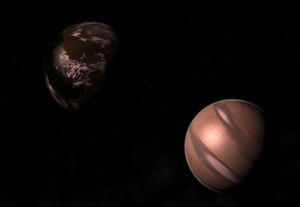Wolf 359
| Wolf 359 | |
| Stellar characteristics | |
|---|---|
| Constellation | Leo |
| Right ascension (Epoch J2000) | 10h 56m 28.99s |
| Declination (Epoch J2000) | +07° 00' 52.0" |
| Spectral type | M6.5 Ve |
| Distance from Sol | 7.78 ± 0.04 ly |
| Other designations | CN Leonis, CN Leo, GJ 406, G 045-020, LTT 12923, LFT 750, LHS 36, GCTP 2553 |
| Planets | Heimdal (Wolf 359 I) Muspellsheimr (Wolf 359 IIa) |
Wolf 359 is a small, dim, type M red dwarf star located approximately 7.7 light years from the Earth in the constellation Leo, near the ecliptic. It is classified as a UV Ceti-type flare star, and has a relatively high flare rate.
Wolf 359 is one of the nearest stars to the solar system; only the Alpha Centauri system and Barnard's Star are known to be closer.
Neither a Hubble search, nor a cursory fly-by by the Trekkies in late 2009 seemed to suggest the existence of a planetary. when the SS Fram visited Wolf 359 in a projected six month mission, it did detect a planetary system of four planets and one asteroid belt, with two planets forming a double planet system. That is was not detected is based on the systems ecliptic being different from most other planetary systems detected up to them.
Contents
Planets
Heimdal
Named after the warden of Odin, Heimdal is a planet of the Hot-Neptune type, orbiting Wolf 359 in a closer orbit then Mercury orbits Sol. Because of this closeness, Heimdal does not possess any moons.
Muspellsheimr and Nifelheimr
This double planet system the single most important discovery of the entire Wolf 359 mission of the SS Fram as both planets are, while being situated well outside the Green Zone, bearing life. However both worlds are polar opposites.
Muspellsheimr
Named after the Norse Primordial element of Fire, Muspellsheimr, this planet is just that. Twice the size of Earth with a surface gravity of 1.5g, the planet is extremely geologically active and is currently the world with the most volcanoes. The planet does have a Nitrogen-Oxygen atmosphere, but it is not breathable by humans due to the presence of various toxins and a pressure of 10 bar on the planetary surface. Even through not close enough to its sun top be heated by it, the volcanic activity heats the atmosphere to a cozy 40 degrees Celsuis at average.
About 50 percent of the surface are covered by water through it is more of a thick soup like sludge containing a large amount of volcanic ash and sand. However it is also teething with microbial life as well as higher developed life forms.
The lower atmosphere of Muspellsheimr is likewise rather thick with volcanic ash and microbial life, making it hard to see further then about fifty meters at good times of a day.
This does not preclude the existence of higher forms of life however. The dominant life form is a eight legged elephantine creature that absorbs food directly through its skin by processing the thick atmosphere. They were named FROB by the crew of the SS Fram. Other lower life forms exist as well, through there are no known predators due to the presence of nutriments all around them.
Nifelheimr
Named after the Norse Primordial element of Ice, Muspellsheimr, this planet is just that. Being the size of Titan, this planet is not as geological active as its twin, but enough to warm it up slightly. However the surface temperature does not raise over about -30 degrees Celsius with the common temperature being about -45 degrees Celsius.
Surrounded by a nitrogen atmosphere similar to Titan and a surface pressure of 1 bar, ammonia oceans and seas cover its surface.
Ammonia is also the base of the first sort of cryogenic life discovered. Dominant life forms are large moving plant like creatures that are named 'Ymir' by the crew of the SS Fram.
Hel
Hel, named after the Norse plane of the dead, is the outer most planet of the Wolf 359 system and again a icy Neptune like object with a ring system and at least three moons.
